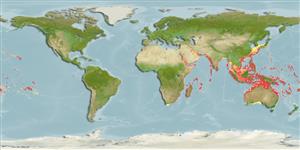Common names from other countries
Environment: milieu / climate zone / depth range / distribution range
Écologie
marin récifal; profondeur 0 - 135 m (Ref. 89972), usually 1 - 12 m (Ref. 90102). Tropical; 38°N - 36°S, 19°E - 124°W
Indo-Pacific: Red Sea and East Africa to the Hawaiian, Marquesan and Ducie islands, north to the Ryukyu and Ogasawara islands, south to the Great Barrier Reef, Lord Howe, and Rapa.
Taille / Poids / Âge
Maturity: Lm ? range ? - ? cm
Max length : 32.0 cm SL mâle / non sexé; (Ref. 1602)
Épines dorsales (Total) : 0; Rayons mous dorsaux (Total) : 11 - 12; Épines anales: 0; Rayons mous anaux: 9 - 10. Posterior part of body with blackish blotches; dorsal, caudal and pelvic fins with dark traverse bands (Ref. 11228).
Inhabits sand and silty reefs (Ref. 58652). Benthic (Ref. 58302). Common in shallow lagoons, reef flats, and sheltered seaward reefs. Feeds on fishes and ocacionally on crustaceans (Ref. 89972). Active at night (Ref. 5213). Caught with artisanal gear. Solitary (Ref 90102).
Life cycle and mating behavior
Maturities | Reproduction | Spawnings | Egg(s) | Fecundities | Larves
Cressey, R.F., 1986. Synodontidae. p. 270-273. In M.M. Smith and P.C. Heemstra (eds.) Smiths' sea fishes. Springer-Verlag, Berlin. (Ref. 4055)
Statut dans la liste rouge de l'IUCN (Ref. 130435)
CITES (Ref. 128078)
Not Evaluated
Menace pour l'homme
Harmless
Utilisations par l'homme
Pêcheries: commercial
Outils
Articles particuliers
Télécharger en XML
Sources Internet
Estimates based on models
Preferred temperature (Ref.
115969): 24 - 29, mean 28 (based on 2080 cells).
Phylogenetic diversity index (Ref.
82804): PD
50 = 0.5000 [Uniqueness, from 0.5 = low to 2.0 = high].
Bayesian length-weight: a=0.00724 (0.00487 - 0.01078), b=3.12 (3.00 - 3.24), in cm Total Length, based on LWR estimates for this species & Genus-body shape (Ref.
93245).
Niveau trophique (Ref.
69278): 4.2 ±0.4 se; based on diet studies.
Résilience (Ref.
120179): Haut, temps minimum de doublement de population inférieur à 15 mois (Preliminary K or Fecundity.).
Fishing Vulnerability (Ref.
59153): Low to moderate vulnerability (29 of 100).
